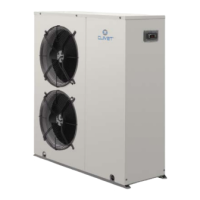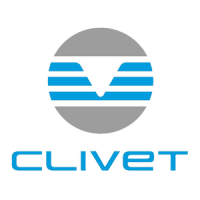M0Q940G14-03 WSAT-XIN 21-171 43
9.6 Control check list
√ intervention frequency (months) 1612
1 presence corrosion X
2 panel xing X
3 fan xing X
4 coil cleaning X
5 water lter cleaning X
6 check the exchanger eciency X
7 circulating pumps X
8 check of the xing and the insulation of the power lead X
9 check of the earthing cable X
10 electric panel cleaning X
11 capacity contactor status X
12 termina closing, cable insulation integrity X
13 voltage and phase unbalancing (no load and on-load) X
14 absorptions of the single electrical loads X
15 test of the compressor crankcase heaters X
16 leak control* X
17 survey of the refrigerant circuit operating parameters X
18 protective device test: pressure switches, thermostats, ow switches etc.. X
19 control system test: setpoint, climatic compensations, capacity stepping, water / air ow-rate variations X
20 control device test: alarm signalling, thermometers, probes, pressure gauges etc.. X
* European regulation 303/2008
Refer to the local regulations; and ensure correct adherance. Companies and technicians that eect interventions of installation, maintenance/
repairs, leak control and recovery must be CERTIFIED as expected by the local regulations. The leak control must be eected with annual
renewal.
9.7 Air coil
Contact with the exchanger ns can cause cuts: wear protective gloves to perform the above described operations.
It is extremely important that the battery gives the maximum thermal exchange; therefore, its surface must be cleaned from dust and deposits.
Remove all impurities from the surface.
Using an air pressure gun, clean the aluminum surface of the battery; be careful to direct the air in the opposite direction of the fan air
movement.
Hold the gun parallel to the ns to avoid damages.
As an alternative, vacumn cleaner can be used to suck impurities from the air input side.
Verify that the aluminum ns are not bent or damaged, in the event of damages contact the authorized assistance center and get the ns
straightened in order to restore the initial condition for an optimal air ow.
9.8 Water side exchanger
It is very important for the exchanger to be able to provide the maximum thermal exchange, therefore it is essential for the inner surfaces to
be clean of dirt and incrustations.
Periodically check the dierence between the temperature of the supply water and the condensation temperature: if the dierence is greater
than 8°C–10°C it is advisable to clean the exchanger.
The clearing must be eected:
•
with circulation opposite to the usual one
•
with a speed at least 1,5 times higher than the nominal one
•
with an appropriate product moderately acid (95% water + 5% phosphoric acid)
•
after the cleaning rinse with water to inhibit the action of any residual product

